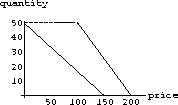Suppose a small town has offered to give you the rights to provide cable TV service to families in the town. As a merchandiser you are interested in maximizing your profits. You are told that there are 100 families in the town who do not have cable TV. The cost to you of providing cable TV is $20 per month per family as well as $2000 in monthly overhead that is related to maintenance of your equipment and does not depend on how many families you service.
Fifty families live in houses and fifty families live in apartments.
It has been estimated that people living in houses are more desirous of having cable TV. If you charge a price of p for a cable TV hookup, the following expression gives the number of families living in houses, qh, who will pay for a hookup.

The following expression for qa gives the number of families living in apartments that will pay for a cable TV hookup if you charge a price p.

Economists usually call these demand curves (or demand functions). The town that is giving you the franchise will only allow you to set one price for cable TV. These "piecewise defined" functions may be defined on the computer, and there is help in the program MonopolyHelp on our website.

Figure 28.1: Demands for Cable TV
Your first task as monopolist is to determine what price you would charge for cable TV. We will determine this by solving a maximization problem in the exercises below. If you decide to charge a price p for cable TV, how many families in houses will buy a cable TV hookup? How many families living in apartments will buy a hookup? Determine expressions in terms of the price, p, of cable TV. These expressions will depend on what interval the price p lies in.

Figure 28.2: Cable Revenue

Figure 28.3: Cost for Providing Cable TV
Since your profit function is defined in pieces, you must solve more than one maximization problem. Your profit is a continuous function of your price, so the Extreme Value Theorem guarantees that there is a price that will maximize your profits. Why is it continuous? What are the endpoints for your maximization problems?

Figure 28.4: Profit for Providing Cable TV at a Single Price
28.2
Suppose instead of going into business, you are part of the government of the small town that has given someone the right to provide cable TV. The cable TV company has been in business several years and has led to some complaints.
The biggest complaint has come from people living in apartments.
They complain that the price of a cable TV hookup is so high that they can't afford it, and they want you to do something that will allow them to enjoy cable TV as well.
The monopolist claims that he must charge a high price to remain in business but suggests that you allow him to charge different prices to apartments and homes.
What pair of prices maximizes profit? How many houses and apartments are served at these prices?
How large a service fee could the town charge and still allow you to stay in business?